Understanding the Landscape of Emergency Dental Visits
Emergency dental visits represent a significant public health concern with far-reaching implications. This article explores the statistical data on emergency dental visits in the United States, pinpointing the most urgent causes and identifying demographic, socioeconomic, and systemic factors that contribute to these care episodes. By examining patterns, costs, and outcomes, we provide an in-depth understanding of dental emergencies and highlight opportunities for improving oral health and reducing emergency care reliance.
Prevalence and Economic Impact of Emergency Dental Visits in the US
How frequently do emergency dental cases occur, and how are they distributed over time?
In the United States, around 2 million visits to emergency departments (EDs) each year are due to dental problems, making up roughly 1.5% of all ED visits. These cases include issues like dental abscesses, severe toothaches, and traumatic injuries. The volume of these visits can vary depending on factors such as access to routine dental care, social vulnerability, and community resources.
Recent data from 2020 to 2022 shows a decline in ED visits for tooth disorders, decreasing from 88.4 to 59.4 visits per 10,000 people. Despite the reduction, adults aged 25 to 34 remain the largest group seeking emergency dental care, accounting for nearly 30% of visits.
The distribution of these cases indicates that many are evaluative or involve prescriptions rather than definitive treatment, with a frequent return rate—about 43% of patients revisit within 30 days. Emergency dental visits tend to fluctuate throughout the year, often rising in seasons with limited access to dental clinics, and are particularly high among uninsured populations and low-income communities.
Overall, these emergency visits are not only common but also represent a significant and persistent challenge for the healthcare system, contributing to millions of dollars in costs annually.
Most Common Causes of Emergency Dental Visits
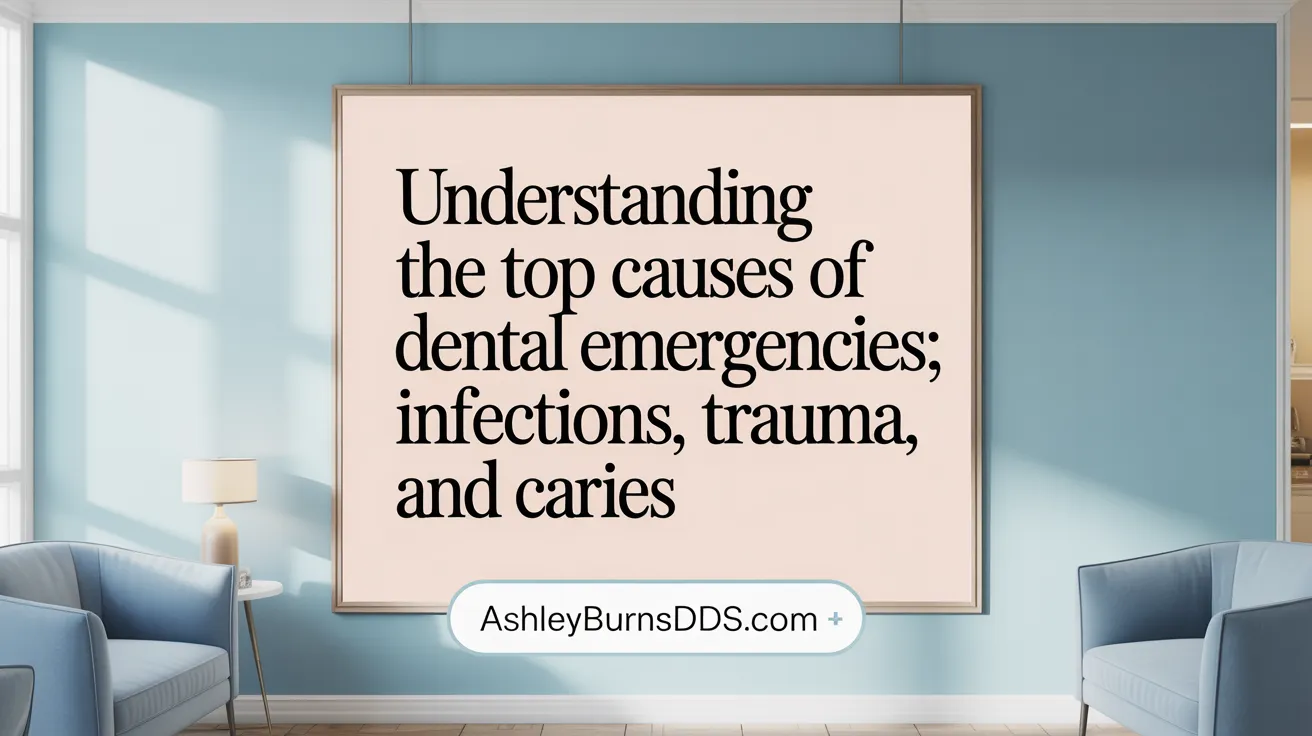
What are the most common causes of emergency dental visits?
The most frequent reasons people seek emergency dental care in the U.S. are dental caries, abscesses, and diseases affecting the pulp and periapical tissues. These conditions together account for nearly 80% of dental-related emergency room visits, illustrating how untreated tooth decay and infections rapidly escalate into urgent health issues.
Dental infections, such as abscesses presenting as painful, swollen lumps on the gums, are particularly serious because they can spread swiftly through the bloodstream, posing life-threatening risks if not promptly treated. In addition to infections, dental trauma, including knocked-out or fractured teeth, represents a significant subset of cases, especially among adults aged 18 to 44 years.
Most visits are evaluative, with about 28% of cases involving no other procedure besides assessment, highlighting that many patients present with severe pain or swelling without immediate definitive treatment. Common diagnoses made in EDs include loss of teeth, diseases of the pulp and tissues surrounding the teeth, and dental caries, which remain the primary culprits.
The treatment approach often revolves around pain management and infection control. Opioids and antibiotics are frequently prescribed, although efforts are underway to reduce reliance on opioids, with nonopioid analgesics becoming more common.
In summary, dental caries and infections account for a majority of emergency visits, with trauma also contributing notably. Most emergency care focuses on managing acute symptoms rather than providing definitive, preventive dental treatment, highlighting the need for improved access to routine dental care.
Demographic and Situational Factors Influencing Urgent Dental Care
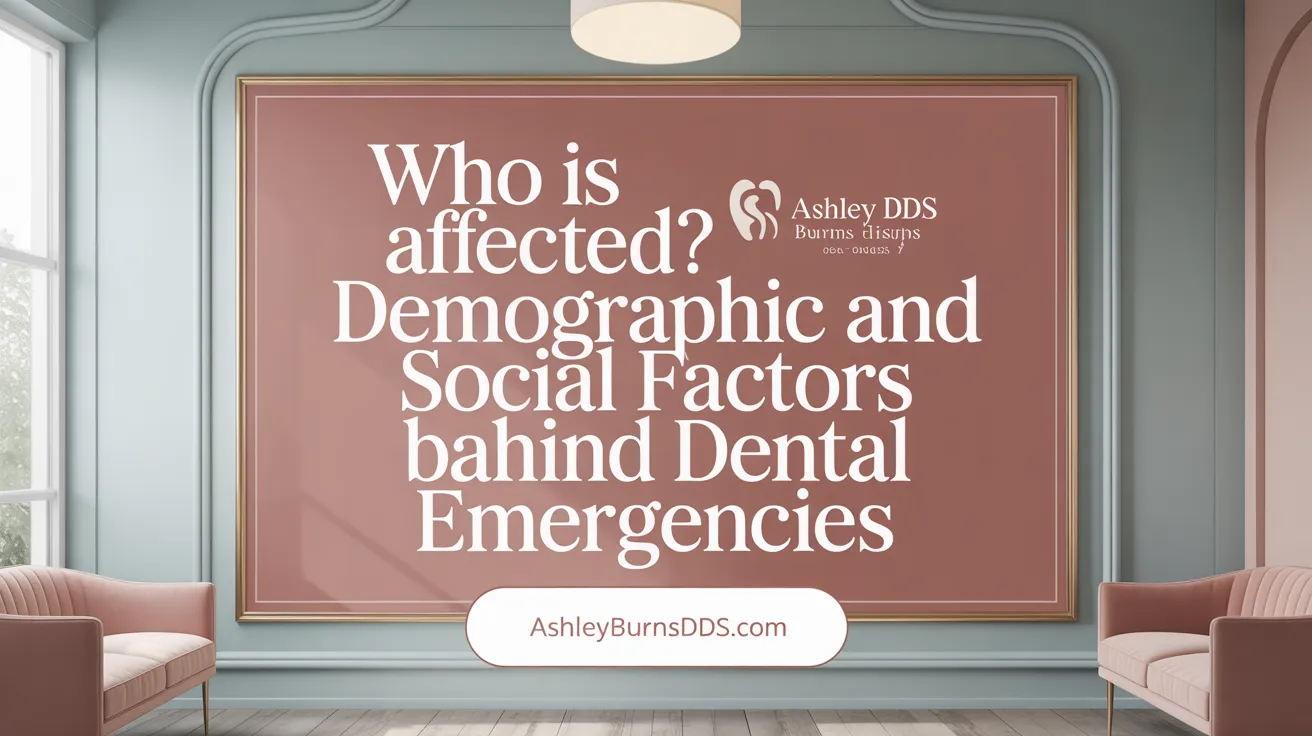
Which demographic and situational factors contribute to the frequency of urgent dental care visits?
Women aged 21 to 34 are the most frequent users of emergency departments (EDs) for dental problems. This group, along with adults aged 25 to 34, constitutes the largest segment presenting with tooth disorders in emergency settings. Their higher utilization might be linked to various factors such as limited access to routine dental care or dental fears.
Uninsured individuals and Medicaid recipients make up most of the emergency dental visitors, with collectively over 80% of the visits. Specifically, uninsured patients are 5.2 times more likely to visit the ED for dental issues compared to those with commercial insurance. This disparity highlights how financial barriers and lack of coverage push vulnerable populations toward emergency services.
Social vulnerability plays a significant role. Areas with higher social determinants of health — such as low income, poor access to dental providers, and limited community water fluoridation — show higher rates of emergency dental visits. Populations living in rural or underserved communities often depend more heavily on emergency services due to unmet preventive care needs.
Populations in low-income communities or with limited oral health literacy are less likely to seek routine dental care, leading to a reliance on EDs for urgent needs. Dental fears or mistrust of dental care might also contribute, preventing early intervention.
Situational triggers include the severity of untreated dental disease, such as abscesses and caries, which can cause pain and swelling—medical emergencies requiring immediate attention. Additionally, limited availability of dental providers, inflexible dental office policies, and inadequate dissemination of dental health resources exacerbate the issue.
Overall, demographic realities such as age, gender, race, socioeconomic status, and insurance coverage, combined with social and systemic barriers, strongly influence how frequently people seek urgent dental care in emergency settings.
Underlying Patterns and Reasons Behind Dental Emergencies
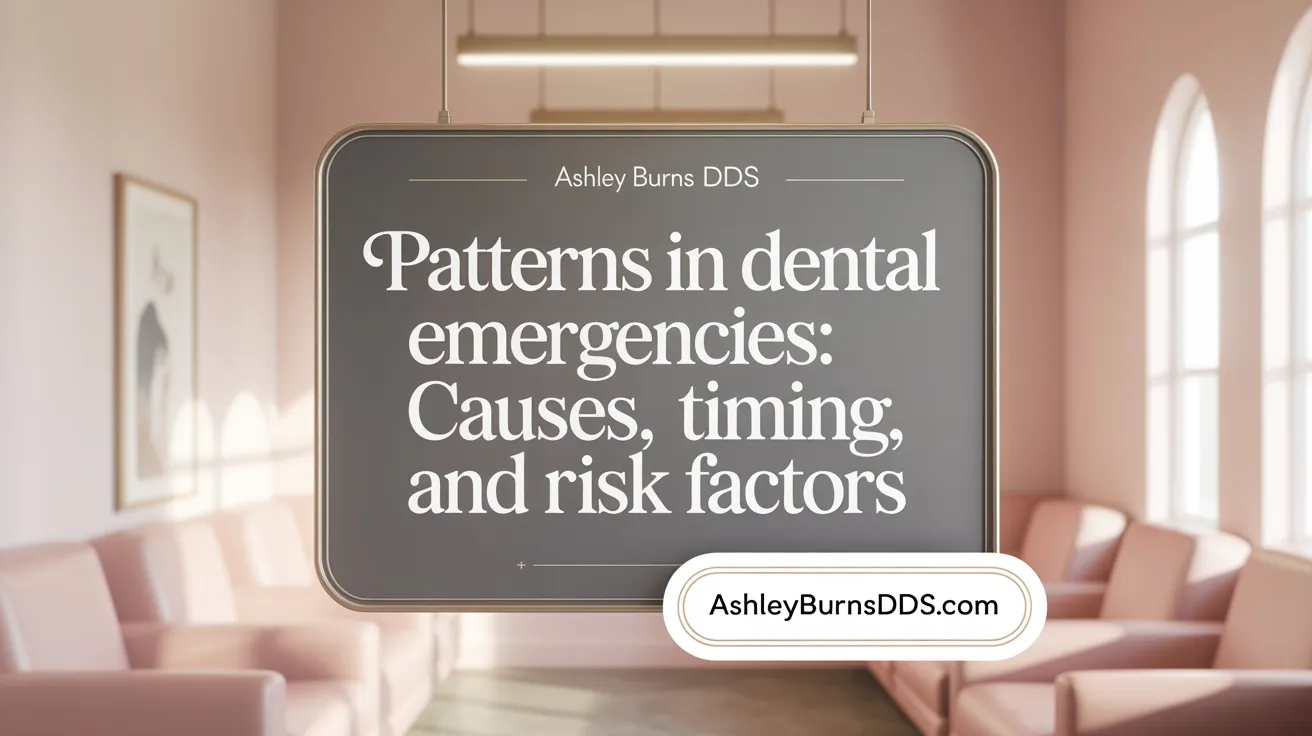
What patterns and reasons underlie dental emergencies prompting urgent care?
Dental emergencies often arise due to traumatic injuries or infectious issues that have developed over time. Traumatic incidents like falls, sports injuries, or accidents are common causes, leading to broken or knocked-out teeth. Such injuries typically occur suddenly and require immediate attention to preserve oral health.
Infectious causes frequently stem from untreated dental decay. When cavities are left untreated, they can evolve into pulpitis or abscesses—severe infections that cause painful swelling and sometimes systemic health risks if not addressed quickly. These infections develop rapidly and can worsen with delays in treatment.
Pattern recognition indicates that poor oral hygiene habits, inadequate access to dental care, and lack of routine preventative services contribute significantly to emergency scenarios. Many patients face barriers such as limited coverage, financial constraints, or fear, which hinder timely care.
Post-procedural issues, including bleeding, pain, or delayed healing, can also prompt emergency visits, especially when complications arise after dental treatments.
Overall, these emergencies highlight the crucial need for early diagnosis, regular preventive care, and timely interventions. Addressing social determinants of health and improving access to dental services are essential strategies to reduce the frequency of urgent dental complications and improve overall oral health outcomes.
Frequency Trends and Temporal Distribution of Emergency Dental Cases
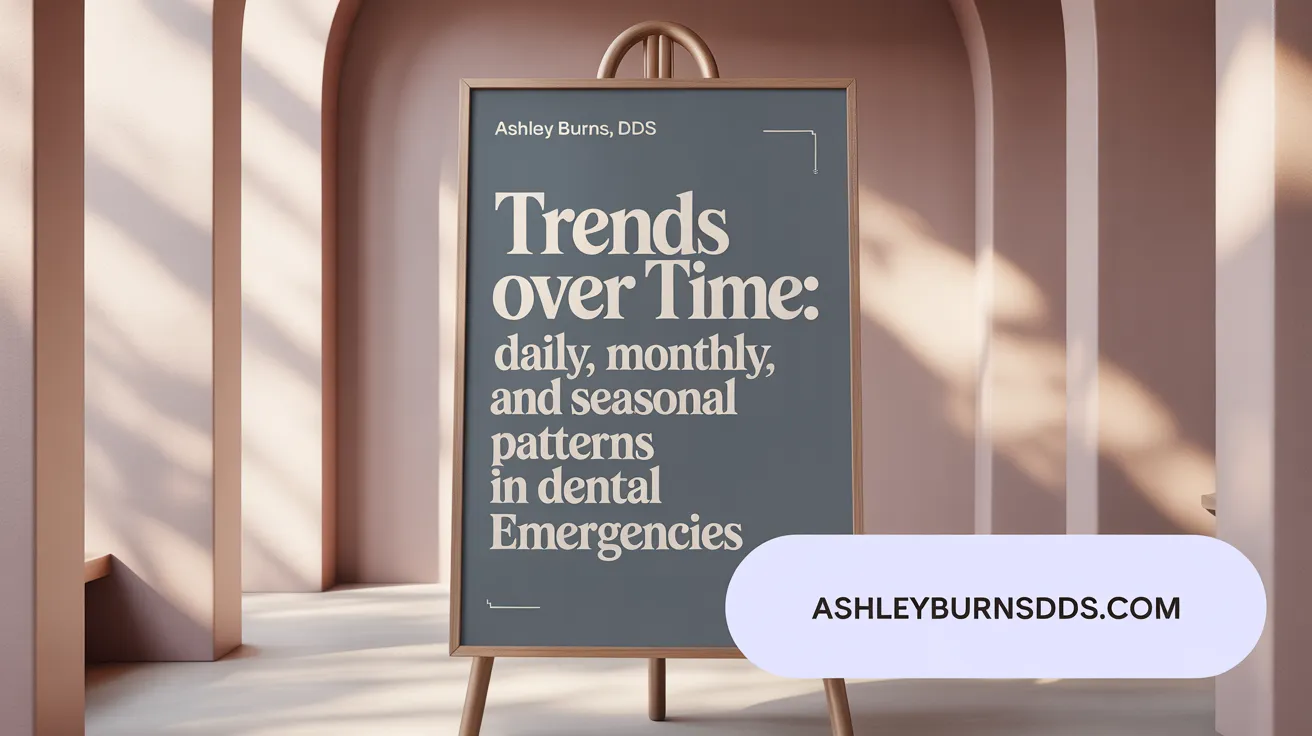
How frequently do emergency dental cases occur, and how are they distributed over time?
Emergency dental visits are relatively common, with rates ranging from approximately 59 to 88 visits per 10,000 people in the U.S. These figures reflect a fluctuating pattern over recent years, influenced by factors like healthcare access, social determinants, and broader healthcare utilization trends.
Between 2014 and 2016, the rate of emergency dental visits was higher, but a notable decline has been observed by 2020–2022. During this period, the rate dropped to around 59.4 visits per 10,000 people. This decrease correlates with broader healthcare changes, including the impact of the COVID-19 pandemic, which led to reductions in routine and emergency dental visits across the country.
The pandemic caused a temporary dip in overall dental care access, but emergency cases persisted as people delayed elective treatments and defaulted to hospital emergency rooms for urgent issues. This resulted in a significant proportion of dental emergencies being evaluated or treated in hospital settings rather than dental offices.
Weekly and seasonal patterns also influence emergency dental visit distribution. Higher peaks are often noted during weekends and holidays, possibly due to limited access to regular dental care and the need for urgent relief. Additionally, certain times of the year, such as the end of the calendar year, see increased activity as individuals rush to utilize dental benefits before they expire.
Annual fluctuations are affected by various social and health factors, including community water fluoridation, insurance coverage, and public health initiatives. Regions with limited access to dental providers and higher social vulnerabilities tend to experience higher emergency dental visit rates.
These temporal trends underscore the importance of improving access to regular dental care and addressing the social determinants that lead individuals to seek emergency services for preventable dental issues.
Impact of Dental Emergencies on Public Health and Healthcare Systems
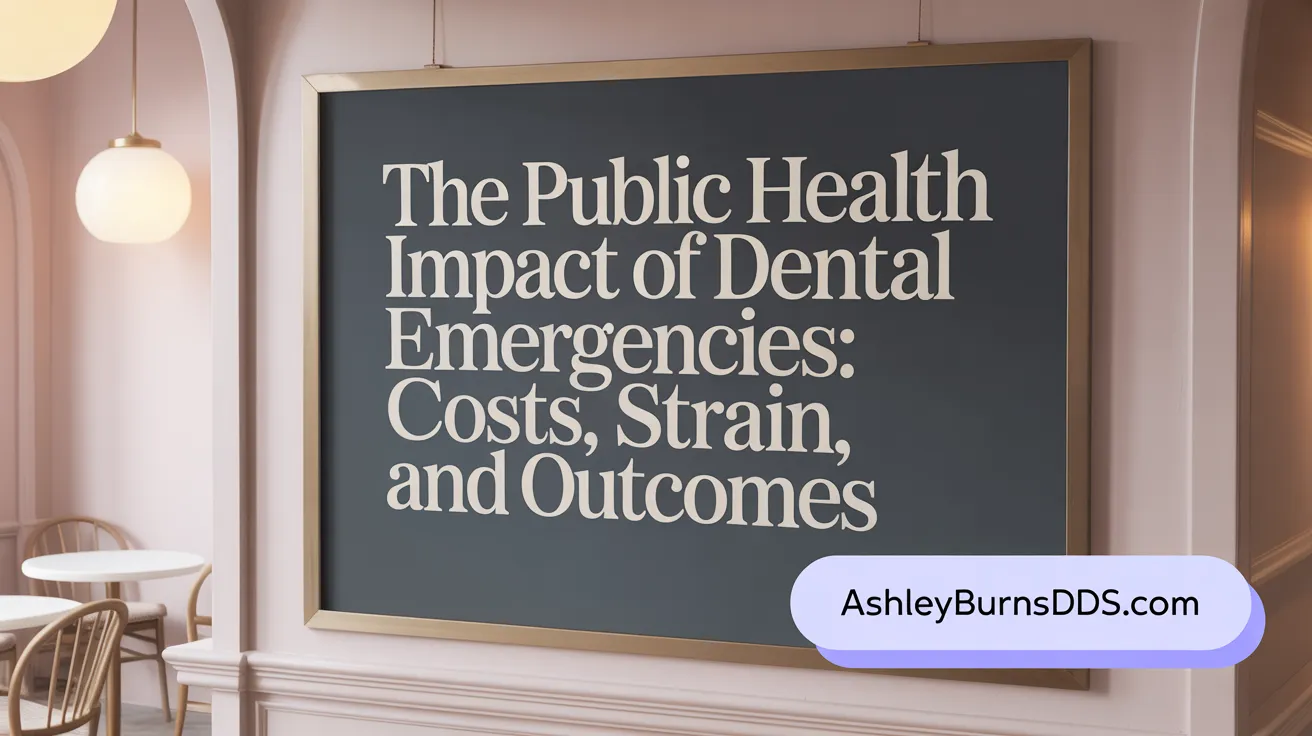
What impact do dental emergencies have on public health and healthcare systems?
Dental emergencies significantly burden the U.S. healthcare infrastructure through extensive use of emergency departments (EDs). Each year, over 2 million visits are due to non-traumatic dental issues such as abscesses and severe caries, many of which are preventable with routine dental care. These visits tend to be high-cost, averaging around $749 per visit without hospitalization, accumulating to more than $2 billion annually.
Most of these patients are uninsured or rely on Medicaid, with data showing that nearly half of ED dental visitors have no insurance and a third are on Medicaid. These populations often depend on EDs because of limited access to regular dental services, resulting in repeated visits for palliative treatments rather than definitive care.
The systemic inefficiencies are evident as many visits are evaluative or involve prescriptions, primarily opioids and antibiotics, rather than permanent dental procedures. This pattern not only inflates healthcare costs but also contributes to issues like opioid dependence and antibiotic resistance.
In addition, the high recurrence rate of dental-related ED visits underscores gaps in preventive care and systemic integration between dental and medical services. Failures in community water fluoridation, low provider availability in vulnerable communities, and limited Medicaid benefits exacerbate these challenges.
Overall, the strain on healthcare resources from dental emergencies highlights the need for better preventive strategies, expanded dental coverage, and improved access to routine dental care, which could alleviate the financial and systemic impact on public health.
Factors Driving Increases and Decreases in Emergency Dental Visits Over Time
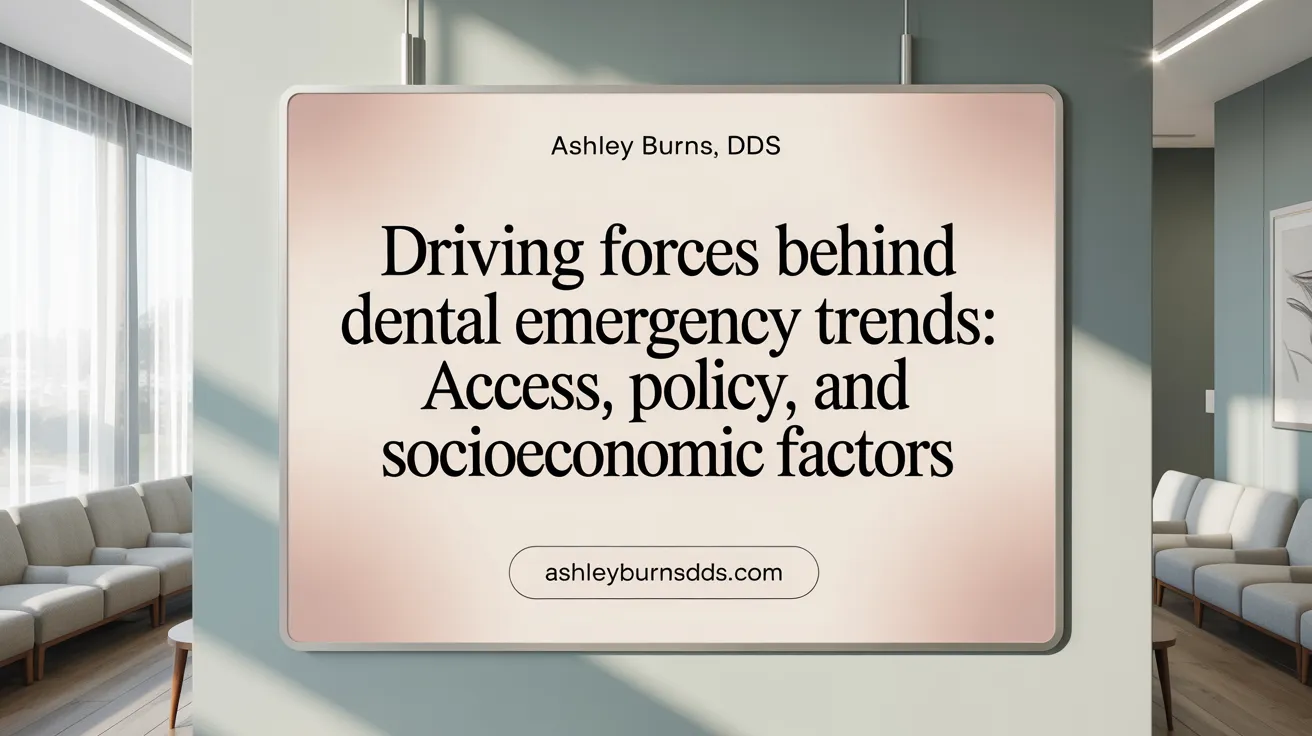
Which factors lead to increases or decreases in emergency dental visits over time?
The patterns of emergency dental visits are shaped by several interrelated factors, primarily centered around access to dental providers and Medicaid coverage.
Areas with more dental care providers tend to see fewer emergency visits, as residents can obtain timely, definitive dental treatments rather than relying on emergency services for urgent care. Conversely, in communities with limited dental resources, residents often turn to emergency departments (EDs) for help, driving up visit rates.
Medicaid coverage plays a critical role in this dynamic. States that have expanded dental benefits within Medicaid frameworks generally report lower ED dental visits. This is evident from studies showing that routine dental care, like annual cleanings, reduces the likelihood of emergency visits in such states.
Socioeconomic status and social vulnerability significantly influence ED utilization for dental problems. Communities characterized by lower income, limited water fluoridation, and higher racial or ethnic minority populations tend to have higher ED visit rates. Areas with high social vulnerability often have fewer dental providers and less access to preventive care, resulting in a cycle of urgent, unresolved dental issues.
Recent trends indicate a decreasing rate of ED visits for dental conditions since 2014. This decline correlates with efforts to improve dental access and changes in clinical management.
Changes in clinical practices have also impacted emergency dental care. Notably, the use of opioids for pain relief has decreased substantially—from about 38% of visits in 2014–2016 to 16.5% in 2020–2022—favoring nonopioid analgesics. This shift reflects increased awareness of opioid risks and better adherence to pain management guidelines.
Overall, although ED visit rates have declined over recent years, disparities rooted in access, socioeconomic factors, and social vulnerability continue to influence who seeks emergency dental care. Effective strategies focus on expanding dental provider availability, enhancing Medicaid benefits, and addressing social determinants of health to reduce unnecessary ED visits.
Strategies to Reduce Urgent Dental Emergencies: Prevention and Education
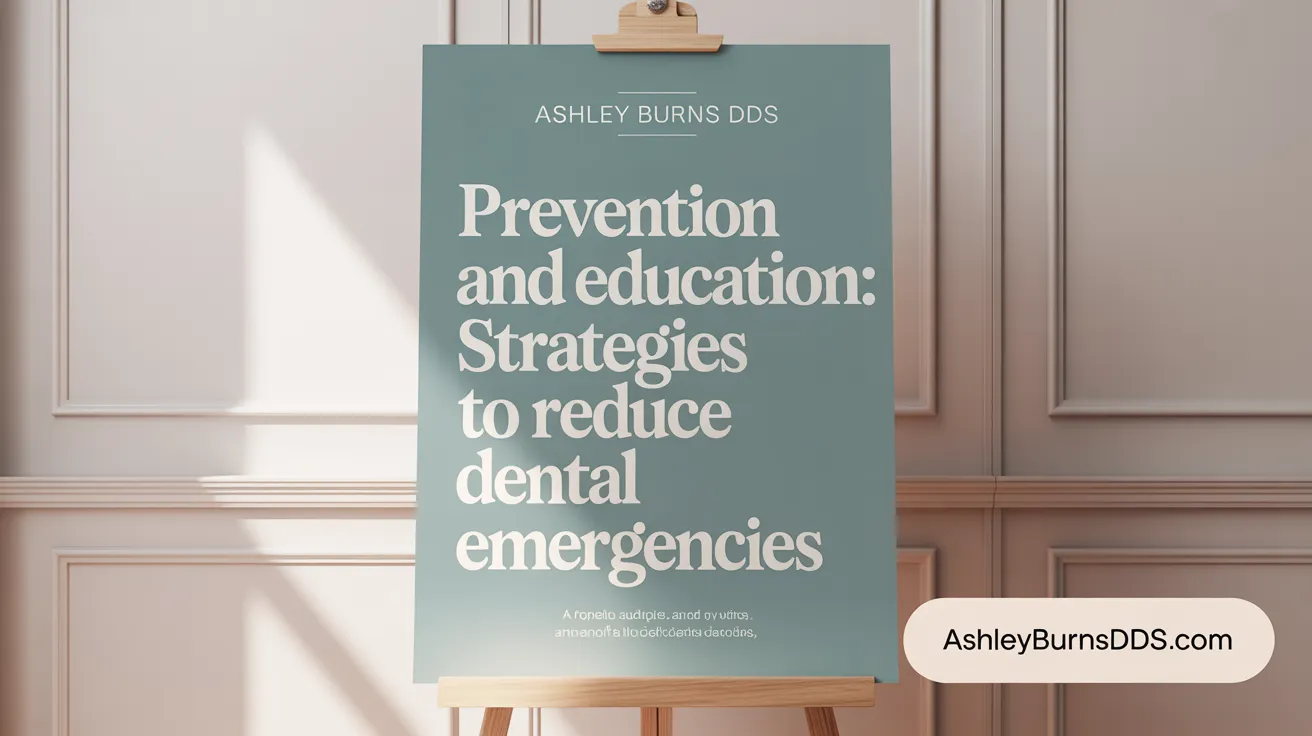
What measures or solutions can help reduce the incidence of urgent dental emergencies?
Implementing effective preventive measures is essential for decreasing emergency visits related to dental issues. Regular oral hygiene practices, such as brushing teeth twice a day with fluoride toothpaste and flossing daily, are the foundation to prevent dental diseases that often lead to emergencies. Routine dental check-ups allow for early detection and treatment of issues like cavities, abscesses, and gum disease, stopping problems from becoming severe.
Protective devices play a vital role, especially in injury-prone activities. Wearing mouthguards during sports can significantly reduce the risk of dental trauma, a common cause of emergency visits. Additionally, avoiding harmful habits such as nail-biting, teeth grinding, or using teeth as tools can prevent damage.
Early intervention is crucial—if minor dental problems are treated promptly, they are less likely to escalate into emergencies. Community-based education initiatives and public awareness campaigns further support this effort by informing individuals about the importance of regular dental care and recognizing signs of urgent issues.
By combining personal habits with access to preventive dental services and community outreach efforts, it is possible to lessen the frequency and severity of dental emergencies. These strategies not only improve individual oral health but also help reduce overall healthcare costs and emergency department burdens.
| Prevention Strategies | Practical Actions | Additional Benefits |
|---|---|---|
| Oral hygiene and routine check-ups | Brush twice daily, floss daily, visit dentist regularly | Reduced cavities, gum disease, and abscesses |
| Injury prevention | Wear mouthguards, avoid risky habits | Less trauma-related emergencies |
| Public education | Community programs, awareness campaigns | Empowered individuals, early problem detection |
Efforts focusing on prevention and education are practical and impactful ways to address the high rates of urgent dental emergencies, easing the strain on emergency healthcare services and improving community oral health.
Demographics and Social Disparities in Emergency Dental Care Utilization
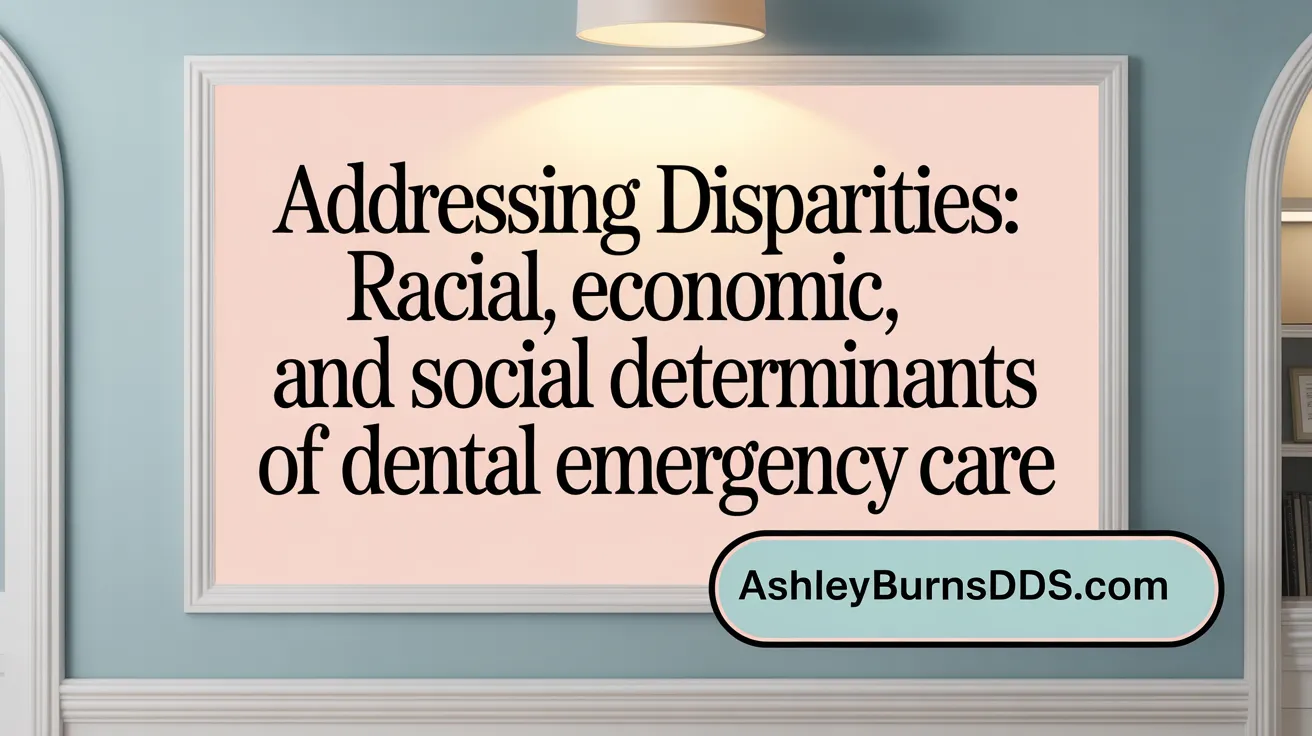
What are the racial, ethnic, and income disparities in emergency dental visits?
Emergency dental visits in the U.S. are not evenly distributed across all population groups. Data from 2018 shows that non-Hispanic Black individuals had the highest population rate of dental-related emergency department (ED) visits, about 1,362.4 per 100,000 people. Similarly, individuals living in the lowest income communities experienced rates as high as 1,069.1 per 100,000.
Racial and economic disparities play a significant role in access to regular dental care and prevention. Many of these high-risk groups tend to rely more heavily on EDs for dental issues because of limited access to routine dental services, often compounded by a lack of dental insurance.
How do different population groups compare in rates of emergency visits?
Certain demographics are more likely to seek emergency dental care. Adults aged 18-44 years show the highest population rate at 1,107.4 visits per 100,000. Among racial groups, non-Hispanic Blacks and Hispanics also frequently use EDs for dental problems, with 31.9% of dental ED visits made by Black non-Hispanic individuals and 14.5% by Hispanics.
Overall, these figures highlight that vulnerable populations, especially those with lower incomes and certain racial backgrounds, are overrepresented in emergency dental care statistics.
What is the role of social determinants of health?
Social factors such as income level, racial and ethnic background, and community resources significantly influence the likelihood of using emergency services for dental issues. Areas with greater social vulnerability, which include limited access to healthy foods, fewer dental care providers, and barriers related to citizenship status, have higher rates of ED visits for dental problems.
Expanding access to dental services, through initiatives like Medicaid dental benefits, and addressing social vulnerabilities are essential steps to decrease preventable emergency visits. Improving community water fluoridation and increasing dissemination of dental health information can also help mitigate disparities, ensuring all population groups have better oral health care options.
| Population Group | Rate of Dental ED Visits per 100,000 | Major Contributing Factors |
|---|---|---|
| Non-Hispanic Black Individuals | 1,362.4 | Limited access to preventive dental care, low income |
| Lowest Income Communities | 1,069.1 | Financial barriers, lack of insurance |
| Adults aged 18-44 | 1,107.4 | Younger adults less likely to have dental insurance |
| Overall | Approximately 615.5 per 100,000 | Socioeconomic and racial disparities |
Addressing these disparities requires a multi-faceted approach involving policy changes, community programs, and increased health literacy, aiming to provide equitable dental care access for all.
Insurance Status and Its Role in Emergency Dental Visits
Impact of Medicaid and uninsured status
Many patients seeking emergency dental care in the U.S. are either uninsured or on Medicaid. Nearly half (49.3%) of ED dental visitors lack insurance, and about 32.8% are on Medicaid. Uninsured individuals are significantly more likely to visit EDs for dental issues—being 5.2 times more prone to have a dental-related emergency than those with commercial insurance.
These groups often turn to emergency departments because they lack access to regular dental care, either due to financial constraints or limited dental coverage under Medicaid. Consequently, untreated dental problems frequently escalate into painful infections, necessitating urgent care.
Insurance as predictor for ED use
Insurance status strongly predicts the likelihood of emergency dental visits. Data show that Medicaid recipients constitute the majority of patients, accounting for over 55% of ED dental visits. Conversely, privately insured patients make up about 19.3%, while uninsured patients account for roughly 12.2%.
Research indicates that individuals with better dental insurance or access to regular dental services are less likely to rely on EDs. For instance, states with comprehensive dental benefits under Medicaid experience fewer emergency visits, suggesting that insurance coverage directly influences dental health outcomes.
Financial barriers to preventive dental care
Financial barriers prevent many from seeking routine dental services. Limited Medicaid benefits, high out-of-pocket costs, and lack of community water fluoridation contribute to low preventive care usage.
The resulting gap in care leads to worsening dental conditions, which then require emergency interventions. Since ED visits are considerably more costly—averaging around $749 without hospitalization—these preventable emergencies pose a significant economic burden.
Expanding dental coverage, especially under Medicaid, and improving access can reduce emergency dental visits. Addressing financial and systemic barriers is essential for enhancing oral health and reducing high healthcare costs.
| Aspect | Data/Statistics | Implications |
|---|---|---|
| Uninsured ED visitors | 49.3% uninsurance rate | Higher reliance on emergency services |
| Medicaid coverage | 55.4% primary payment | Significant role in dental emergencies |
| Cost of ED visits | Average $749 | High financial burden |
| Preventive care impact | State benefits lower ED use | Better coverage reduces emergencies |
| Racial disparities | Higher rates among non-Hispanic Black individuals | Socioeconomic factors influence access |
Efforts to improve coverage and reduce financial hurdles could lead to significant reductions in preventable emergency dental visits, easing the strain on hospitals and improving oral health outcomes.
Patterns of Treatment and Follow-Up After Emergency Dental Visits

High proportion of evaluative visits
Many emergency department (ED) visits for dental problems are primarily evaluative, meaning they involve examination and diagnosis without immediate definitive treatment. Data shows that about 28% of dental encounters were evaluative, with no additional procedures performed during those visits. These visits often include radiographs or assessments aimed at identifying the issue rather than solving it immediately.
Prescription practices, including opioid use
Prescribing habits at ED visits for dental issues vary, but opioids are frequently dispensed, especially for pain management. In recent years, the use of opioids has decreased—down from 38.1% of visits in 2014–2016 to about 16.5% in 2020–2022. Instead, nonopioid analgesics are now the most common choice for pain relief, reflecting a shift towards safer prescribing practices.
Rates of follow-up visits and definitive treatment
A significant number of patients return within a short period for additional dental care after their initial ED visit. Approximately 43% return within 30 days to seek more definitive treatment, such as restorations or extractions. Despite the initial evaluation, many ED visits do not lead to immediate definitive procedures, emphasizing a cycle where urgent care addresses symptoms temporarily without resolving the underlying dental issues.
| Aspect | Data | Details |
|---|---|---|
| Main visit type | Evaluative (~28%) | No immediate procedures, mostly diagnosis-oriented |
| Opioid prescriptions | 56% in initial visits | Majority of pain relief involves opioids, but declining |
| Follow-up visits | 43% within 30 days | Many patients seek further treatment after initial eval |
| Principal conditions | Tooth loss, pulp diseases | Common diagnoses leading to ED visits |
| Treatment during visits | Mostly radiographs and prescriptions | Definitive treatments often delayed to follow-up visits |
Understanding these patterns highlights the importance of improved access to preventive dental services and coordinated care. Addressing these issues may reduce unnecessary ED visits and improve long-term oral health outcomes.
Role of Dental Provider Availability and Access in Emergency Visit Reduction
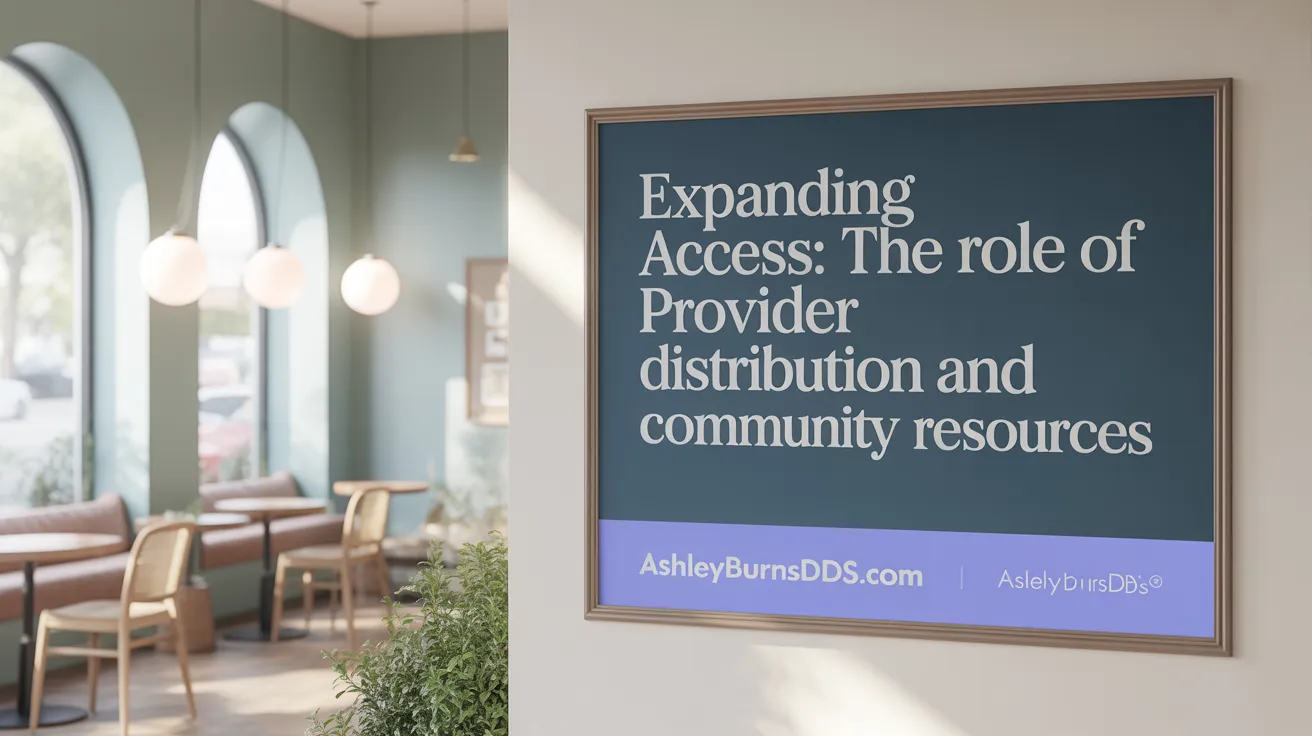
Correlation between provider density and ED visits
Research shows a clear link between the number of dental providers in a community and the frequency of emergency department (ED) visits for dental issues. Areas with more dentists tend to have fewer emergency visits, highlighting the importance of accessible dental care. When patients can easily see a dentist for regular check-ups and treatments, they are less likely to seek urgent care for preventable dental conditions.
Importance of dental workforce distribution
The distribution of the dental workforce plays a critical role in reducing emergency visits. Regions with a higher concentration of dental professionals can better meet community needs, especially in underserved populations. Conversely, places with fewer dentists often see increased reliance on EDs, as residents lack timely access to regular dental services.
Community-level interventions to improve access
Efforts to improve access include expanding Medicaid dental benefits, increasing the number of dental providers in vulnerable areas, and implementing community-based programs. These interventions have proven effective; for example, states that invested in expanding dental services saw significant reductions in emergency dental visits. Addressing social barriers and enhancing community resources are essential components of reducing emergency dental care reliance.
| Aspect | Impact | Additional Details |
|---|---|---|
| Provider Density | Higher density correlates with fewer ED visits | Increased access allows for preventive and routine care |
| Distribution | Equitable workforce distribution reduces disparities | Targeted placement in underserved areas improves outcomes |
| Community Interventions | Expand Medicaid benefits, education, outreach | Examples include mobile clinics and local dental programs |
Fostering better distribution of dental providers and community engagement is crucial for decreasing avoidable emergency dental visits, ultimately saving costs and improving oral health outcomes.
Common Types and Severity Levels of Dental Emergencies
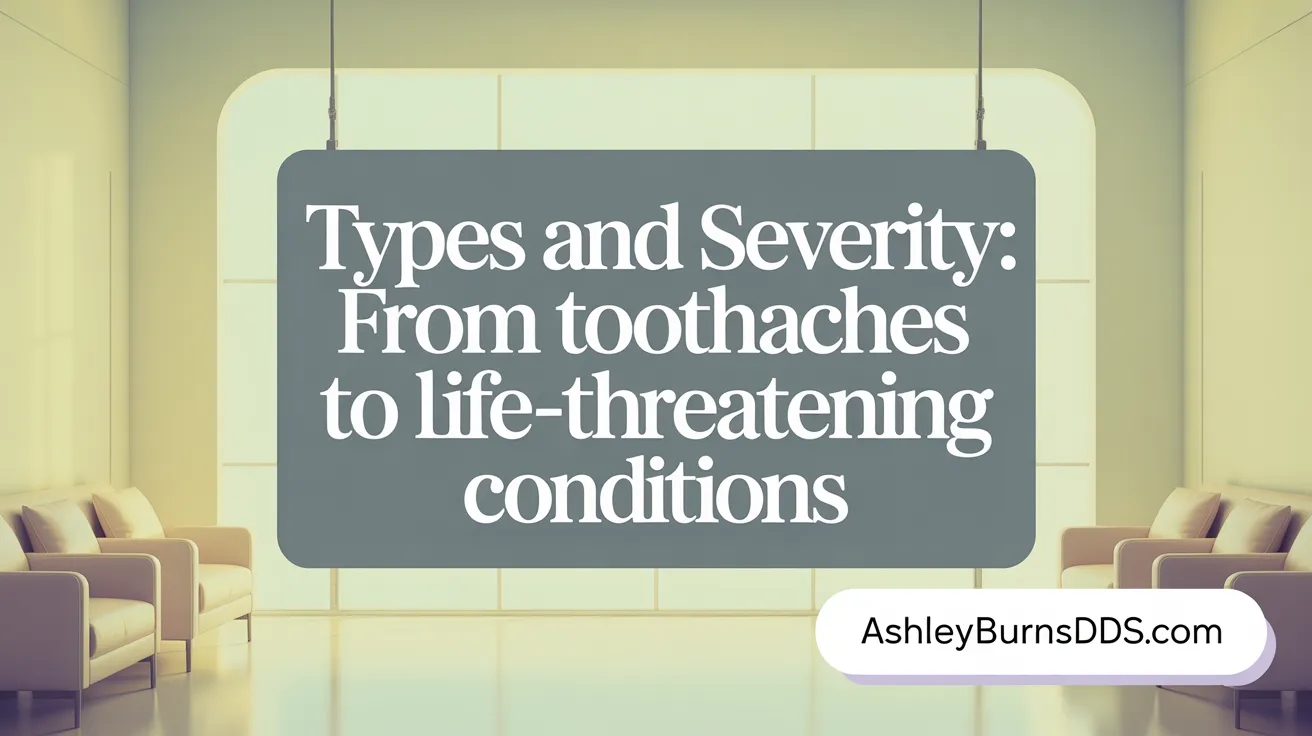
What are the nature and severity of common dental emergencies requiring urgent care?
Dental emergencies encompass a broad spectrum, ranging from minor discomforts to life-threatening conditions. Milder issues often include toothaches caused by cavities or minor chips in the teeth. These typically cause discomfort but do not pose immediate health risks.
However, certain dental situations demand urgent attention due to their severity. These include avulsed (knocked-out) teeth, severe abscesses, and extensive trauma. An avulsed tooth, if reinsertion occurs within 30 minutes, has a better chance of saving the tooth. Severe abscesses present as swollen, painful bumps on the gums and can lead to serious infections if left untreated.
Signs indicating a severe dental emergency include intense, unrelenting pain, significant facial swelling, fever, signs of systemic infection, or uncontrolled bleeding. These symptoms suggest an infection spreading beyond the local area, which could become life-threatening.
In some cases, dental injuries involve facial fractures or bleeding that interfere with breathing or swallowing. Such severe emergencies often require immediate hospital care to prevent further health risks and to ensure stabilization of the patient.
Timely recognition of these severe symptoms is essential for preventing complications like sepsis or the spread of infection. Emergency intervention in these cases is crucial, often involving procedures such as drainage, antibiotics, or surgery, which can be performed in hospital emergency departments or specialized dental clinics.
Challenges in Integration of Medical and Dental Care Affecting Emergency Visits
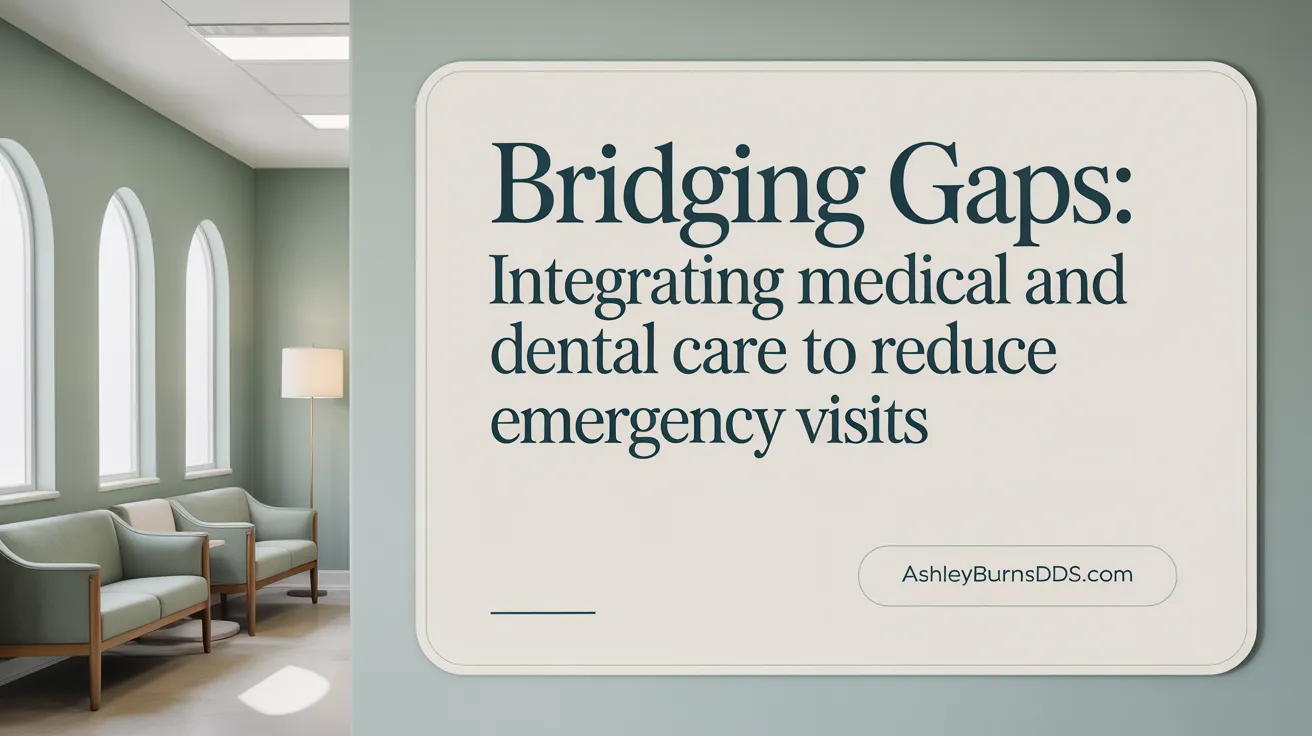
Lack of coordinated care pathways
One significant barrier leading to high emergency department visits for dental issues is the absence of well-structured care pathways that seamlessly connect emergency medical treatment and routine dental care. Patients often resort to ED visits because they lack access to primary dental providers or preventive services. Without clear referral systems and integrated treatment plans, emergency departments become the default venue for urgent dental conditions, often resulting in episodic care rather than comprehensive solutions.
Impact of limited Medicaid dental benefits
Limited coverage under Medicaid further exacerbates this issue. Many vulnerable populations rely on Medicaid for healthcare, but comprehensive dental benefits are often lacking or inconsistent. As a result, individuals frequently fail to receive necessary preventive or restorative dental care, leading to advanced infections or pain that requires emergency intervention. Studies show that expanding Medicaid dental services can significantly decrease emergency dental visits, emphasizing the importance of policy changes to improve access.
Barriers in disseminating dental resource information
Another obstacle is the insufficient dissemination of information about available dental resources and community programs. Many individuals remain unaware of affordable dental clinics, local health initiatives, or outreach services that could prevent emergency cases. Poor communication and limited community engagement hinder the ability of patients to seek appropriate care early, increasing reliance on emergency departments for conditions that could otherwise be managed proactively.
Efforts to improve integration should focus on establishing better referral systems, expanding Medicaid coverage, and enhancing public awareness campaigns. Addressing these barriers can reduce unnecessary emergency visits, lower healthcare costs, and improve overall oral health outcomes.
The Role of Opioid and Antibiotic Prescriptions in Emergency Dental Care
Prevalence of opioid and antibiotic use
In U.S. emergency departments (EDs), pain management is a common concern during dental visits. Data shows that over half of these visits result in prescriptions for opioids or antibiotics, with opioids prescribed in about 28% of adult cases. Antibiotics, mainly penicillin and clindamycin, are also frequently dispensed, highlighting the reliance on these medications for immediate relief.
Trends towards nonopioid pain management
However, recent trends indicate a shift towards safer pain relief strategies. Over recent years, the use of opioids alone has significantly decreased from 38.1% in 2014–2016 to just 16.5% in 2020–2022. Instead, nonopioid analgesics have become the preferred option, reflecting increased awareness of opioid risks and efforts to limit their use.
Concerns about prescriptions during ED visits
This high rate of prescription has raised concerns about potential overuse and dependency, especially given that many ED visits are evaluative, with no definitive treatment provided during the initial encounter. Excessive reliance on opioids and antibiotics can contribute to community health issues like addiction and antibiotic resistance. It also raises questions about the appropriateness of prescribing practices, considering the availability of alternative treatments and the importance of addressing underlying dental conditions.
Addressing these concerns involves improving access to preventative dental care, encouraging evidence-based prescribing, and educating both providers and patients about safe pain management options. Such measures aim to reduce unnecessary prescriptions while ensuring effective relief for those experiencing dental emergencies.
Predicting Future Trends in Emergency Dental Visits Using Data Analytics and Policy Modeling
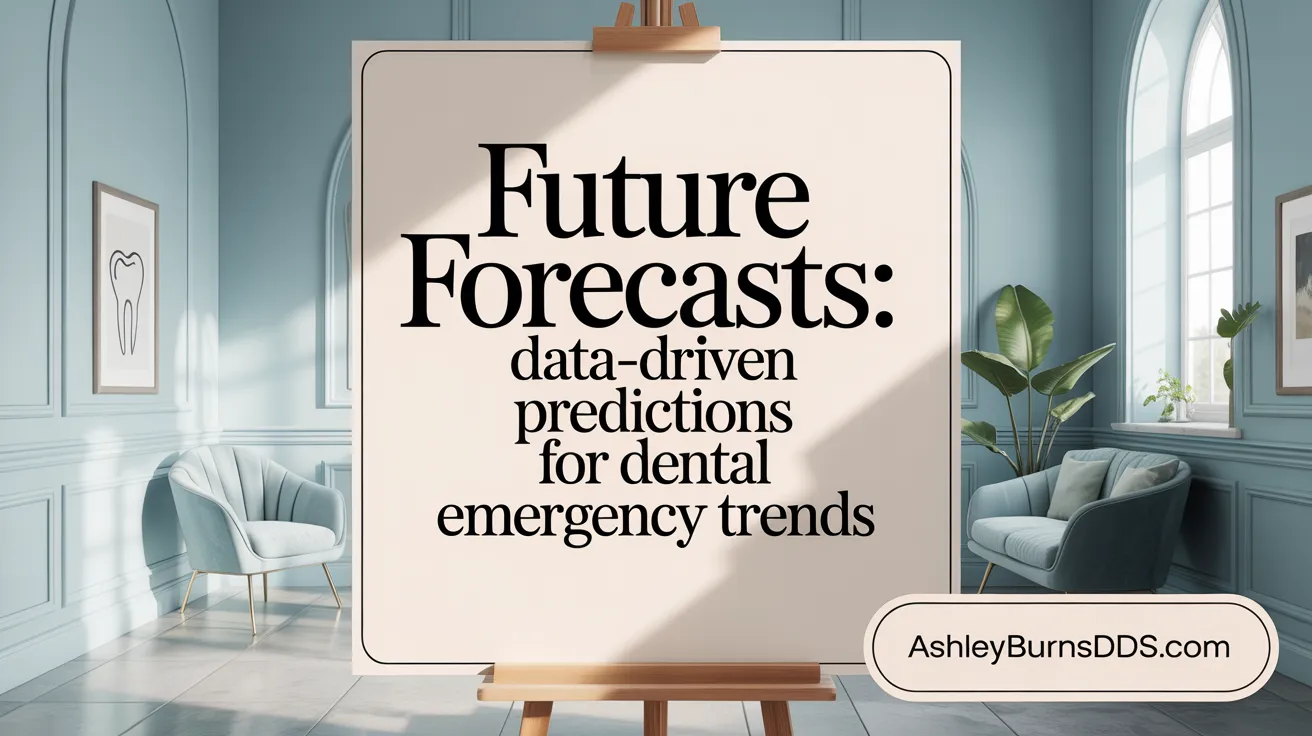
How can future trends in emergency dental visits be predicted based on current data?
Forecasting the future of emergency dental visits relies heavily on analyzing existing epidemiological data and demographic information. Big data tools facilitate the identification of populations at greater risk—such as uninsured individuals, minorities, or residents of low-income communities—highlighting areas where interventions could be most effective.
By examining healthcare access patterns and social determinants of health, public health officials can project potential increases or decreases in emergency visits. For example, expansion of Medicaid dental benefits or improvements in community water fluoridation could reduce urgent dental needs in certain populations.
Technological advances further influence these trends. AI-driven diagnostics and machine learning models can detect emerging risk factors and predict surges in dental emergencies. Meanwhile, innovations like 3D printing enable rapid production of dental supplies and prostheses, potentially reducing emergency treatment times.
Additionally, the rise of tele-dentistry offers avenues for early intervention, reducing the frequency of costly emergency room visits. Policy shifts promoting insurance reforms and telehealth adoption serve to improve access to routine dental care, ultimately preventing many emergencies.
By integrating these data sources and technological developments into predictive models, healthcare systems can allocate resources more efficiently and develop targeted public health strategies. Proactive measures based on big data insights will better prepare systems to meet the evolving demands of emergency dental care, improving outcomes and reducing costs.
Case Studies Demonstrating Successful Reduction in Emergency Dental Visits

ADA Emergency Department Referral Program overview
The American Dental Association (ADA) launched the Emergency Department Referral Program to address the high volume of urgent dental issues treated in hospital emergency rooms. The goal of the program is to steer patients away from costly ER visits toward more appropriate dental care settings, such as dental offices, which can offer definitive treatment at a lower cost. This initiative encourages collaboration among emergency personnel and dental providers to ensure patients receive suitable and timely dental interventions.
Impact and statistics from Michigan and Maine
Programs in states like Michigan and Maine demonstrate the effectiveness of these referral efforts. Michigan reported a 72% decrease in emergency dental visits after implementing the program, indicating significant progress in reducing unnecessary ER utilization. Similarly, Maine observed up to a 70% reduction in some hospitals' emergency dental visits. These improvements not only decrease healthcare costs but also improve patient experience by providing targeted, comprehensive dental care.
Benefits of redirecting care to dental offices
Redirecting emergency dental cases back to dental practices can have numerous benefits. It reduces the financial burden on hospitals, with emergency visits costing on average $749 compared to $90–$200 for regular dental visits. Patients benefit from receiving definitive, ongoing care in a more appropriate setting and often experience better oral health outcomes. Additionally, minimizing unnecessary ED visits alleviates pressure on hospital emergency services and helps address disparities — especially for vulnerable populations who are more likely to use ERs for dental problems due to limited access.
| Program Impact | State | Reduction in Emergency Visits | Additional Notes |
|---|---|---|---|
| Michigan | Michigan | 72% | Improved patient outcomes, lower costs |
| Maine | Maine | Up to 70% | Significant decrease in hospital ER use |
By expanding these successful models, more regions can improve dental health access, reduce healthcare costs, and alleviate emergency room overcrowding, creating a more efficient system that prioritizes appropriate care for dental emergencies.
Addressing Emergency Dental Care Challenges for Better Health Outcomes
Emergency dental visits remain a substantial and costly challenge with roots in preventable conditions, systemic disparities, and limited access to timely dental care. By understanding the demographic, socioeconomic, and clinical patterns driving these urgent visits, healthcare providers and policymakers can implement targeted interventions to reduce occurrences. Expanding access to routine dental services, improving integration between medical and dental care, educating the public on preventive strategies, and leveraging data-driven approaches will be crucial in mitigating the burden of emergency dental care. Such efforts promise to enhance oral health equity, reduce healthcare costs, and improve quality of life for vulnerable populations.
References
- Emergency Department Referrals
- Emergency Department Visits for Nontraumatic Dental ...
- Spatial Patterns of Emergency Dental Care Utilization
- Products - Data Briefs - Number 531 - June 2025
- Emergency and urgent dental visits among Medicaid ...
- Predicting emergency department visits for non-traumatic ...
- Common Dental Emergencies Those require ...
- Emergency Department Visits Involving Dental Conditions, 2018
- Emergency Department Referrals
- Emergency Department Visits Involving Dental Conditions, 2018
